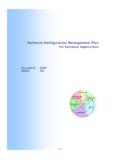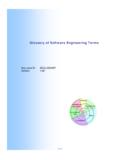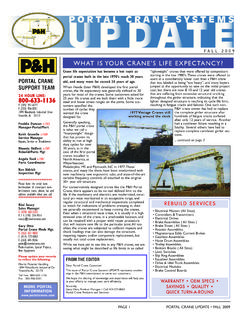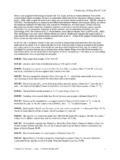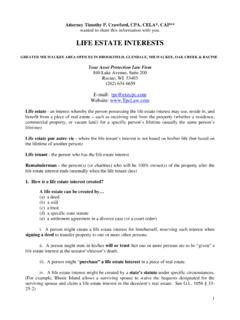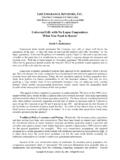Transcription of The Software Development Life Cycle (SDLC) - …
1 The Software Development life Cycle ( sdlc ) For Database Applications Document ID: sdlc Version: PlanningRequirements DefinitionDesignDevelopmentIntegration & TestInstallation & Acceptance 1 / 24 The Software Development life Cycle ( sdlc ) sdlc For Database Applications Version Copyright 2000-2005 Digital Publications LLC. All Rights Reserved. 2 The Software Development life Cycle ( sdlc ) sdlc For Database Applications Version TABLE OF CONTENTS 4 ITERATIVE 4 ROLES AND RESPONSIBILITIES OF PDR AND 5 TRAINING AND 6 COMPONENT-BASED 7 8 ALLOWED 8 8 GENERIC 10 KICKOFF 10 INFORMAL ITERATION 11 FORMAL ITERATION 11 IN-STAGE ASSESSMENT 12 STAGE EXIT 13 sdlc 14 14 PLANNING 15 REQUIREMENTS DEFINITION 16 DESIGN 18 Development 19 INTEGRATION & TEST 20 INSTALLATION & ACCEPTANCE 21 KEY 22 DOMAIN 22 SCOPE 22 PROGRESSIVE 23 PRE-DEFINED 23 INCREMENTAL 23 3 The Software Development life Cycle ( sdlc )
2 sdlc For Database Applications Version INTRODUCTION This document describes the Shell Method Software Development LifeCycle ( sdlc ) for database application Development efforts. This chapter presents an overview of the sdlc and associated references. The following chapter describes the internal processes that are common across all stages of the sdlc and the third chapter describes the inputs, outputs, and processes of each stage. Finally, the conclusion describes the four core concepts that form the basis of this sdlc . ITERATIVE LIFECYCLE This project uses an iterative Development lifecycle, where components of the application are developed through a series of tight iterations.
3 The first iterations focus on very basic functionality, with subsequent iterations adding new functionality to the previous work and/or correcting errors identified for components in production. PlanningRequirements DefinitionDesignDevelopmentIntegration & TestInstallation & Acceptance 4 The Software Development life Cycle ( sdlc ) sdlc For Database Applications Version The six stages of the sdlc are designed to build on one another, taking the outputs from the previous stage, adding additional effort, and producing results that leverage the previous effort and are directly traceable to the previous stages.
4 During each stage, additional information is gathered or developed, combined with the inputs, and used to produce the stage deliverables. It is important to note that the additional information is restricted in scope; new ideas that would take the project in directions not anticipated by the initial set of high-level requirements are not incorporated into the project. Rather, ideas for new capabilities or features that are out-of-scope are preserved for later consideration. Each iteration through the sdlc produces a small, but critical amount of functionality (or enhancements to existing functionality) in a short time frame (generally six to eight weeks).
5 By focusing efforts into a series of tightly scoped iterations, the project minimizes unwarranted scope creep and optimizes staff effort onto manageable, bite-sized project chunks. After each iteration is completed, the Development team generates a list of recommendations for enhancements to be addressed in the next iteration. Too many Software Development efforts go awry when the Development team and customer personnel get caught up in the possibilities of automation. Instead of focusing on high priority features, the team can become mired in a sea of nice to have features that are not essential to solve the problem, but in themselves are highly attractive.
6 This is the root cause of a large percentage of failed and/or abandoned Development efforts and is the primary reason the Development team utilizes the iterative model. ROLES AND RESPONSIBILITIES OF PDR AND PER The iterative lifecycle specifies two critical roles that act together to clearly communicate project issues and concepts between the end-user community and the Development team. PRIMARY END-USER REPRESENTATIVE (PER) The PER is a person who acts as the primary point of contact and principal approver for the end-user community. The PER is also responsible for ensuring that appropriate subject matter experts conduct end-user reviews in a timely manner.
7 PRIMARY DEVELOPER REPRESENTATIVE (PDR) The PDR is a person who acts as the primary point of contact and principal approver for the Development community. The PDR is also responsible for ensuring that appropriate technical experts conduct technical reviews in a timely manner. 5 The Software Development life Cycle ( sdlc ) sdlc For Database Applications Version PER-PDR RELATIONSHIP The PER and PDR are the brain trust for the Development effort. The PER has the skills and domain knowledge necessary to understand the issues associated with the business processes to be supported by the application and has a close working relationship with the other members of the end-user community.
8 The PDR has the same advantages regarding the application Development process and the other members of the Development team. Together, they act as the concentration points for knowledge about the application to be developed. The objective of this approach is to create the close relationship that is characteristic of a Software project with one developer and one end-user. In essence, this approach takes the pair programming concept from Agile methodologies and extends it to the end-user community. While it is difficult to create close relationships between the diverse members of an end-user community and a Software Development team, it is much simpler to create a close relationship between the lead representatives for each group.
9 When multiple end-users are placed into a relationship with multiple members of a Development team, communications between the two groups degrades as the number of participants grows. In this model, members of the end-user community may communicate with members of the Development team as needed, but it is the responsibility of all participants to keep the PER and PDR apprised of the communications. For example, this allows the PER and PDR to resolve conflicts that arise when two different end-users communicate different requirements for the same application feature to different members of the Development team.
10 TRAINING AND QUALIFICATION The Project Team Training and Qualification (PTTQ) plan further describes the roles of the PER and PDR, as well as other personnel supporting the Software Development lifecycle. For each role, the PTTQ provides a description of the activities supported by the role as well as the responsibilities associated with the role. The PTTQ also describes the required training necessary for successful performance of each role, as well as the method of qualification for each role. 6 The Software Development life Cycle ( sdlc ) sdlc For Database Applications Version Finally, the PTTQ describes training resource requirements and training materials made available to project team members.
